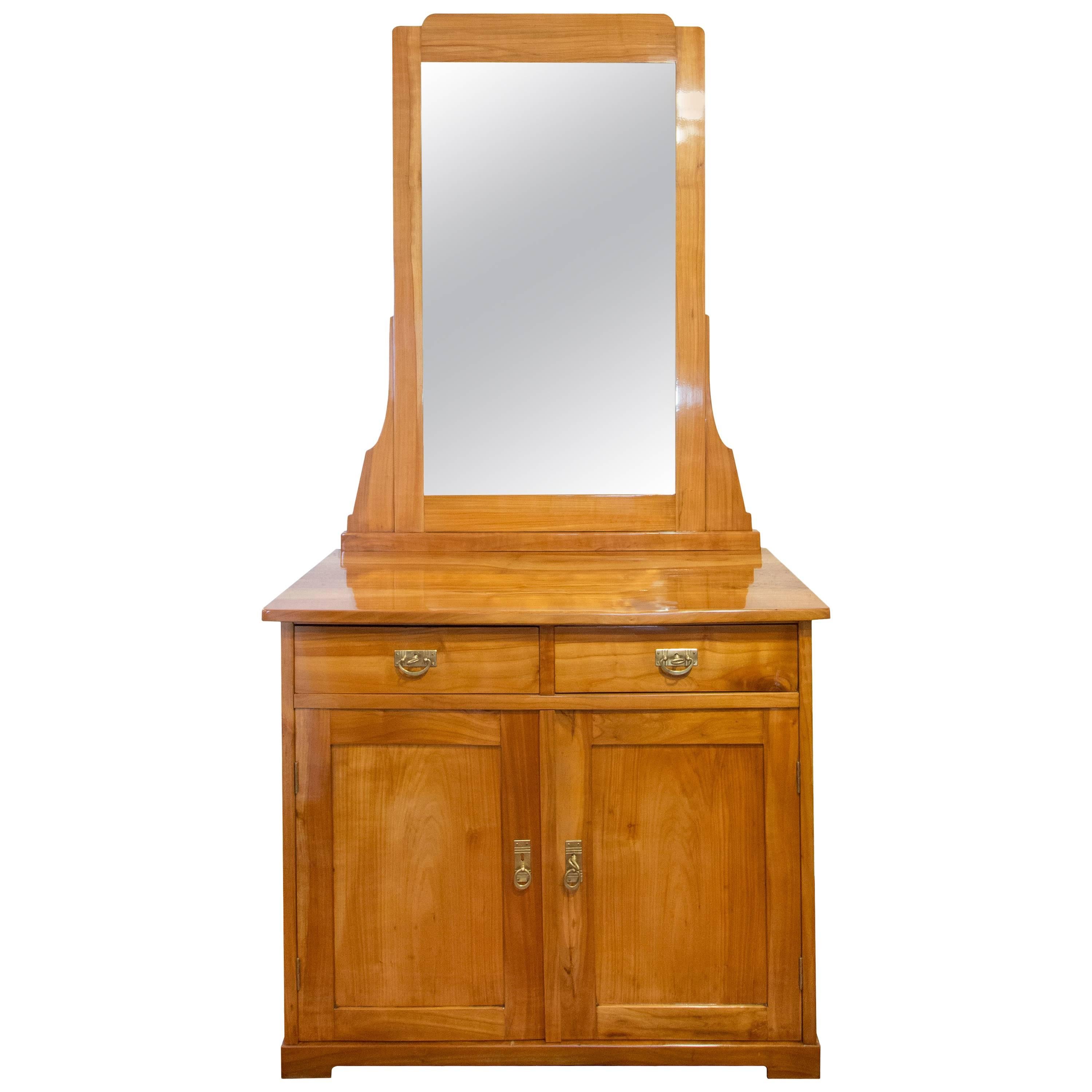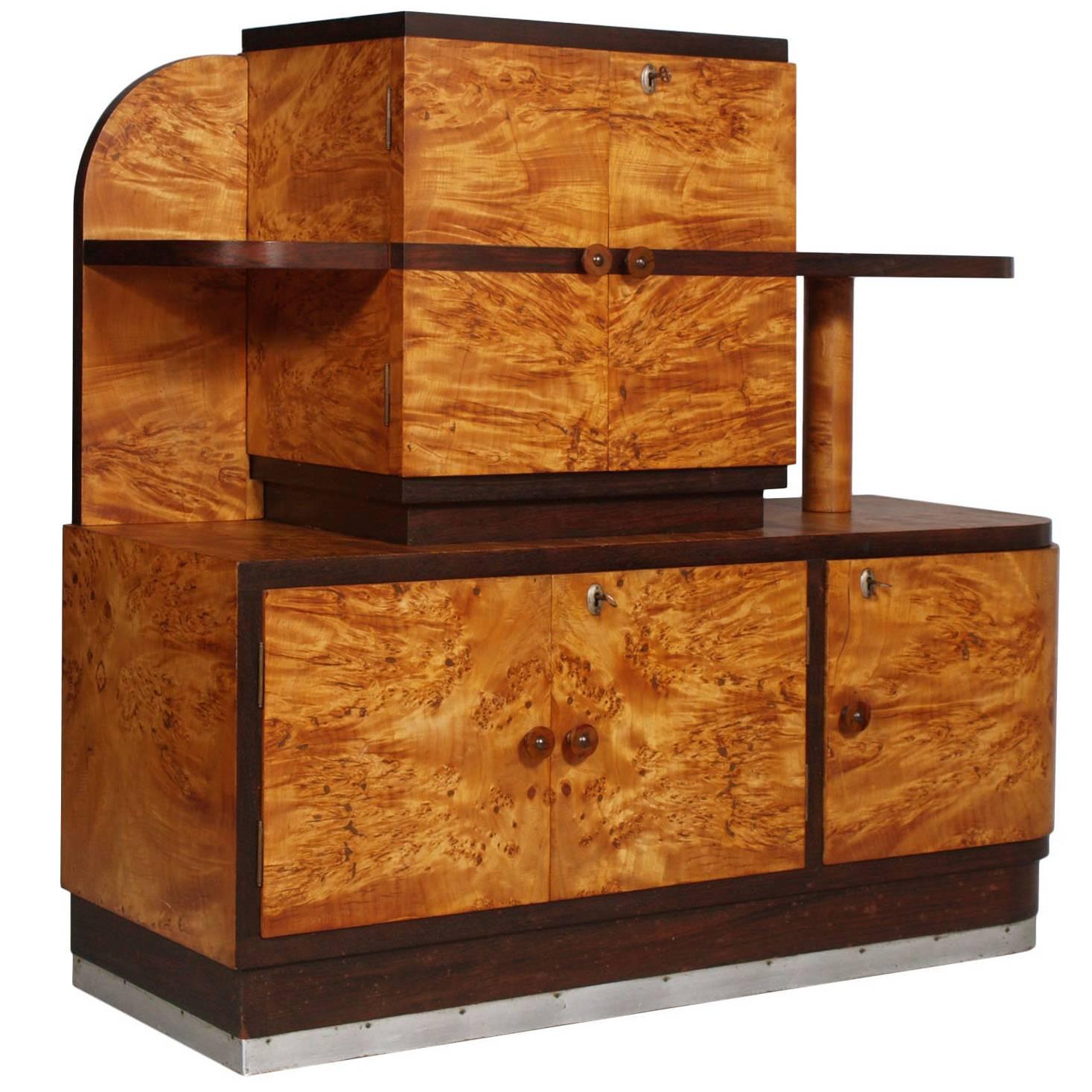Art Deco Entry Cabinet, Vanity or Dressing Table by Osvaldo Borsani , Burl Walnut
About the Item
- Creator:Osvaldo Borsani (Cabinetmaker)
- Dimensions:Height: 76.38 in (194 cm)Width: 49.22 in (125 cm)Depth: 20.87 in (53 cm)
- Style:Art Deco (Of the Period)
- Materials and Techniques:
- Place of Origin:
- Period:
- Date of Manufacture:1930s
- Condition:Wear consistent with age and use.
- Seller Location:Vigonza, IT
- Reference Number:
Osvaldo Borsani
With his stylish and technically innovative furniture, Osvaldo Borsani helped change the face of Italian design in the 1950s and ’60s. His sofas and chairs, featuring deeply upholstered seating and adjustable position settings, have an aura of optimism and efficiency that still seems fresh and lively today.
Born in the commune of Varedo in northern Italy’s Lombardy region, Borsani studied at the Brera Academy in Milan — the same school attended by such luminaries as designer Piero Fornasetti and artist Lucio Fontana — as well as the Polytechnic University of Milan. Borsani first worked for his father’s furniture-making firm, Arredamenti Borsani, an atelier influenced by the more expressive and curvaceous wing of Art Deco design. By 1953, when, along with his twin brother, Fulgenzio — the pair also created this visionary mid-century villa — Borsani opened the furniture company Tecno, his design sensibilities had evolved toward furnishings with strong, simple forms enhanced by mechanical innovations, as with the P40 adjustable armchair (1953). Borsani would be the firm’s lead designer for 30 years, while fostering work by Vico Magistretti, Carlo di Carli, Robin Day and others.
Similar to Gio Ponti in the earliest years of his career, Borsani first created designs marked by lush and buoyant lines: tables with voluptuous curved legs, sofas with undulating backrests. But Borsani’s best-known and most novel pieces date from Tecno’s initial furniture lines: the adjustable D70 sofa, which folds open to make a daybed, and the P40 recliner. The latter — now included in the collections of the Museum of Modern Art and the Victoria & Albert Museum — is an articulated lounger with a back, seat and leg rest that can be moved into 486 different positions. Not only is it extremely comfortable, it is also enduringly chic.
Find a collection of vintage Osvaldo Borsani tables, dining chairs and other furniture on 1stDibs.
- ShippingRetrieving quote...Ships From: Vigonza, Italy
- Return PolicyThis item cannot be returned.
- Art Deco Cabinet Nightstand in Walnut, Burl Walnut Osvaldo Borsani AttributedBy Osvaldo BorsaniLocated in Vigonza, PaduaSculptural Art Deco cabinet nightstand in walnut, burl walnut Osvaldo Borsani attributed for Atelier di Varedo. Original accessories of the era Meas...Category
Vintage 1930s Italian Art Deco Night Stands
MaterialsWalnut, Burl
- Art Deco Mirrored Dressing Table or Vanity by Gaetano Borsani Polished to WaxBy Gaetano BorsaniLocated in Vigonza, PaduaItalian elegant Art Deco mirrored three drowers vanity or dressing table by Gaetano Borsani restored and wax polished. Legs in ebonized walnut, flat surfaces in walnut veneer, edges ...Category
Mid-20th Century Italian Art Deco Vanities
MaterialsBrass
- 1930 Italian Monumental Art Deco Sideboard , Burl Elmwood by Osvaldo BorsaniBy Osvaldo BorsaniLocated in Vigonza, PaduaDescription: a five doors 1930s monumental Italian Art Deco credenza Sideboard Buffet in burl elmwood by Atelier di Varedo Period: 1930 Sty...Category
Vintage 1920s Italian Art Deco Cabinets
MaterialsElm, Walnut, Burl
- 1920s Art Deco Extendable Table by Osvaldo Borsani, in Burl WalnutBy Atelier Borsani Varedo, Osvaldo BorsaniLocated in Vigonza, Padua1930s Art Deco extendable table by Atelier di Varedo, Gaetano e Osvaldo Borsani, in burl walnut polished to wax Measures in cm: W 140+80 D 92 H 80. About Osvaldo Borsani Osvaldo Borsani (born 1911, Varedo, Italy–died 1985, Milano, Italy) was an Italian designer and architect, born into a family of furniture makers with along and well established artisanal tradition. His father, Gaetano Borsani, owned his own furniture shop, the Atelier di Varedo, where the 16-year-old Osvaldo received his first training. At that time, the designer of the atelier was the architect Gino Maggioni, who brought with him influences of the early 20th century Jugendstil movement from Vienna and who instilled in the young Borsani an appreciation for the arts and crafts and furniture making. Osvaldo Borsani first studied fine arts at Accademia di Belle Arti di Brera in Milan, graduating in 1931, and then pursued studies in architecture at Politecnico di Milano, where he graduated in 1936. In 1933, two years before graduating as an architect, Borsani designed the Casa Minima project for the V Triennale di Milano (Milan Triennial), along with architects Cairoli and Varisco. This project earned him a silver medal for its Rationalist code and geometries, and he received positive reviews from the critic Edoardo Persico of Casabella magazine. Villa Borsani And Other Prominent Architectural Work In 1937, Osvaldo Borsani designed Villa Presenti in Forte dei Marmi, a sea town in Tuscany where the Italian aristocracy and industrial elite would build their houses, a project that displayed the same rationalistic rigor displayed in Casa Minima, but softened by the use of mediterranean finishes and materials. Villa Borsani designed by Osvaldo Borsani. Varedo, Italy Villa Borsani. Varedo, Italy In 1943, Osvaldo designed and built his own house, the Villa Borsani, in Varedo, which, despite being conceptualized under strict Rationalist principles, incorporated objects and art of younger artists that communicate a freer approach to the human expression. The Villa Borsani project involved artists such as Adriano Spilimbergo, Fausto Melotti, Lucio Fontana (who made the ceramic fireplace and the ceramic Madonna), and Agenore Fabbri (who made the bronze statue in the staircase). To this day, Villa Borsani has been preserved with most of its original furniture and it remains with Osvaldo Borsani’s family along with the extensive archives of his work. Osvaldo Borsani As a Successful Product and Furniture Designer After Villa Borsani, Osvaldo continued to develop many projects for the Milanese bourgeoisie, frequently with many of the same artists whom he employed for his villa. A particularly strong relationship was the one that Osvaldo developed with artist Lucio Fontana, a close friend since the time of the Accademia de Belle Arti di Brera, and whom Borsani assigned to make a large metal...Category
Vintage 1920s Italian Art Deco Dining Room Tables
MaterialsBurl, Walnut
- 1920s Antique Vanity Baroque Venetian, Dressing Table, Hand Carved Walnut & BurlLocated in Vigonza, PaduaEarly 20th century, antique vanity or entrance console, entry mirror on a hand carved walnut frame, with a gold leaf surface finish. Venetian Baroque cabinet in walnut and burl walnu...Category
Early 20th Century Italian Baroque Revival Vanities
MaterialsMirror, Burl, Walnut
- Art Nouveau Vanity Cabinet, Carved Cherrywood, Bevelled Mirror, Gray Marble TopLocated in Vigonza, PaduaEarly 20th century vanity cabinet Art Nouveau in hand carved solid cherrywood with bevelled mirror and marble top. Handles in burnished brass All solid wood, restored and polished to...Category
Early 20th Century Vanities
MaterialsBrass
- Art Nouveau Cherry Cabinet with Mirror or Vanity CabinetLocated in Darmstadt, DEBeautiful antique, a cabinet with mirror made of solid cherrywood from the period of Art Nouveau. The mirror is facetted. Original fittings and locks made of brass. In very good rest...Category
Antique Early 1900s Art Nouveau Vanities
MaterialsCherry
- Art Deco Vanity / Dressing TableLocated in Pomona, CAA genuine Art Deco vanity / dressing table in mahogany. Chrome hardware and mirror surround. Inset mirror top. Features one cupboard and 2 drawers. ci...Category
Vintage 1930s French Art Deco Vanities
MaterialsMetal
- Osvaldo Borsani CabinetBy Arredamenti Borsani, Osvaldo BorsaniLocated in New York, NYDrinks Cabinet, Model No. 6534B by Osvaldo Borsani for ABV. Mahogany, painted wood, maple, glass, brass. Arredamenti Borsani Varedo edition. This cabinet features 2 front doors that retract into the cabinet revealing a lit interior with mirrored back, 2 glass shelves, 1 pull out wood shelf and 4 lower drawers. Door front painting by Marcello Piccardo.Category
Vintage 1940s Italian Mid-Century Modern Cabinets
MaterialsBrass
- Cabinet with Drawers and Dressing TableBy Studio Art DecoLocated in Saint-Amans-des-Cots, FRCabinet with drawers and dressing table. Red tinted sycamore veneer, solid wenge base. The cabinet presented here was custom-made according to the requests of one of our clients. It ...Category
2010s French Neoclassical Cabinets
MaterialsSycamore, Wenge
- Art Deco CabinetLocated in Pompano Beach, FLFrench Art Deco mini makeup cabinet/table in macassar ebony with elaborately inlaid lemon wood and small drawers.Category
Early 20th Century French Vanities
MaterialsEbony, Macassar
- 1940s Macassar Ebony and Burl Wood Bar Cabinet by Osvaldo BorsaniBy Osvaldo BorsaniLocated in Los Angeles, CA1940s Italian bar / cabinet attributed to Osvaldo Borsani, made of rare Macassar ebony, copper and bronze ornaments on the doors, burl wood inlay ins...Category
Vintage 1940s Italian Mid-Century Modern Dry Bars
MaterialsBronze, Copper
Recently Viewed
View AllRead More
Mid-Century Master Osvaldo Borsani Gets His Due at Donzella
The New York City gallery has devoted its latest show to the work of the modernist Italian designer.
Peek inside Osvaldo Borsani’s Mod Italian Villa
The iconic mid-century estate outside of Milan opens its doors to the public for a very special homage.






